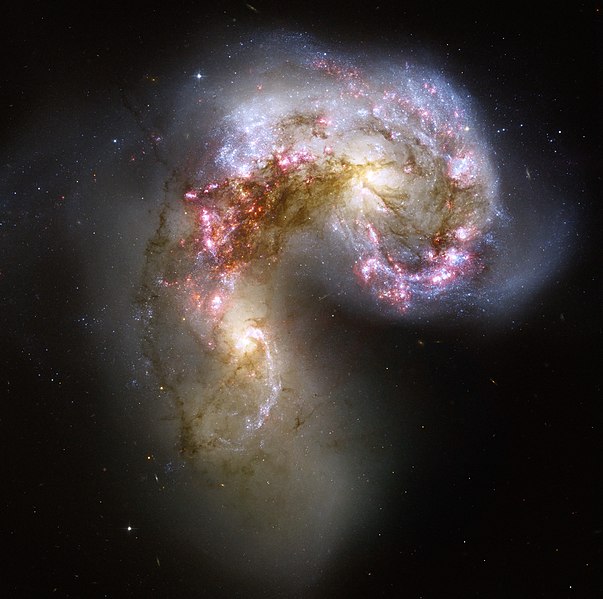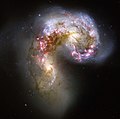File:Antennae galaxies xl.jpg

Original file (3,915 × 3,885 pixels, file size: 14.64 MB, MIME type: image/jpeg)
Captions
Captions
Summary[edit]
| DescriptionAntennae galaxies xl.jpg |
العربية: التعليق الأصلي من الناسا: “هذه الصُورة المُلتقطة بِواسطة مرصد هابل الفضائي تعود لِمجرَّتا الهوائيَّات (NGC 4038 & 4039) وهي أدق صُورة التُقطت حتَّى تاريخها لِهاتين المجرَّتين المُتجاورتين. تتكوَّن مليارات النُجُوم خلال الاصطدام والتداخل بين المجرَّتين. أكثر تلك النُجُوم بريقًا وتراصًّا تُسمَّى عناقيد نجميَّة فائقة.”
“ بدأت هذه المجرَّتان الحلزونيَّتان تتفاعل مع بعضها مُنذ بضعة ملايين السنين، مما يجعل مجرَّتا الهوائيَّات إحدى أقرب وأصغر الأمثلة عن المجرَّات المُتصادمة. حوالي نصف الأجرام الباهتة في الصُورة هي عناقيد نجميَّة حديثة تتكوَّن من عشرات آلاف النُجُوم. النقاط البُرتُقاليَّة الواقعة في يمين ويسار مركز الصُورة هي لُبَّا المجرَّتان الأصليَّتان وتتكوَّن بِشكلٍ رئيسيِّ من نُجُومٍ عتيقة مُتقاطعة مع خُيُوطٍ من الغُبار، تظهر بُنيَّة لِلناظر. المجرَّتان مُرقطتان بِعدَّة مناطق تكوُّن نجميَّة زرقاء لمَّاعة مُحاطة بِهدروجينٍ لامع، تظهر في الصُورة بِاللون الوردي.” English: Original caption from NASA: “This NASA Hubble Space Telescope image of the Antennae galaxies (NGC 4038 & 4039) is the sharpest yet of this merging pair of galaxies. During the course of the collision, billions of stars will be formed. The brightest and most compact of these star birth regions are called super star clusters.”
“ The two spiral galaxies started to interact a few hundred million years ago, making the Antennae galaxies one of the nearest and youngest examples of a pair of colliding galaxies. Nearly half of the faint objects in the Antennae image are young clusters containing tens of thousands of stars. The orange blobs to the left and right of image center are the two cores of the original galaxies and consist mainly of old stars criss-crossed by filaments of dust, which appear brown in the image. The two galaxies are dotted with brilliant blue star-forming regions surrounded by glowing hydrogen gas, appearing in the image in pink.” فارسی: کهکشان ستاره فشان
Français : NGC 4038 et NGC 4039, dites les Galaxies des Antennes, photographiées par le télescope spatial Hubble, de la NASA. Ces deux galaxies sont en train de fusionner, et cette fusion engendre la formation de nombreux amas d'étoiles. Les galaxies des antennes ont commencé à interagir il y a quelques centaines de millions d'années, et constituent l'une des paires de galaxies en interaction gravitaires les plus proches et les mieux visibles du ciel. |
| Date | |
| Source | |
| Author | NASA, ESA, and the Hubble Heritage Team (STScI/AURA)-ESA/Hubble Collaboration |
|

|
This image was selected as picture of the day on Wikimedia Commons for . It was captioned as follows: Other languages:
Dansk: Antennegalakserne i kollision. Billede fra Hubble rumteleskopet. Íslenska: Antennea stjörnuþokurnar í árekstri. Myndin er úr myndasafni Hubble geimsjónaukans. Magyar : A Csáp-galaxisok, két ütköző galaxis (az NGC 4038 és az NGC 4039) a Holló csillagképben. A Hubble űrtávcső felvétele. Nederlands: Het Antennestelsel, bestaande uit de interagerende sterrenstelsels NGC 4038 en NGC 4039 in het sterrenbeeld Raaf, zoals gezien door de ruimtetelescoop Hubble in 2006. Македонски : Галаксиите Антени во судир (слики од „Хабл“). |
Licensing[edit]
| Public domainPublic domainfalsefalse |
| This file is in the public domain because it was created by NASA and ESA. NASA Hubble material (and ESA Hubble material prior to 2009) is copyright-free and may be freely used as in the public domain without fee, on the condition that only NASA, STScI, and/or ESA is credited as the source of the material. This license does not apply if ESA material created after 2008 or source material from other organizations is in use. The material was created for NASA by Space Telescope Science Institute under Contract NAS5-26555, or for ESA by the Hubble European Space Agency Information Centre. Copyright statement at hubblesite.org or 2008 copyright statement at spacetelescope.org. For material created by the European Space Agency on the spacetelescope.org site since 2009, use the {{ESA-Hubble}} tag. |
File history
Click on a date/time to view the file as it appeared at that time.
| Date/Time | Thumbnail | Dimensions | User | Comment | |
|---|---|---|---|---|---|
| current | 18:05, 23 April 2007 |  | 3,915 × 3,885 (14.64 MB) | WilliamKF (talk | contribs) | == Description == This new NASA Hubble Space Telescope image of the Antennae galaxies (NGC 4038 & 4039) is the sharpest yet of this merging pair of galaxies. During the course of the collision, billions of stars will be formed. The brightest and most comp |
You cannot overwrite this file.
File usage on Commons
The following 80 pages use this file:
- Featured Pictures in the Public Domain
- User:Hidayatsrf/Gallery
- User:John Cummings/gallerytest
- User:Jorghex
- User:Miya/POTY/2010/Objects
- User:Nigreco451/FPGallery
- User:Thib Phil/My page: Sci-fi
- User:Ö/Best/2010
- User talk:LuisArmandoRasteletti
- User talk:MrPanyGoff/Archive
- Commons:Closed most valued reviews/2011/05
- Commons:Featured picture candidates/File:Antennae, Hubble images.jpg
- Commons:Featured picture candidates/File:Antennae galaxies xl.jpg
- Commons:Featured picture candidates/Log/June 2010
- Commons:Featured pictures/Astronomy
- Commons:Featured pictures/chronological/2010-A
- Commons:Gambar Pilihan/Astronomi
- Commons:Picture of the Year/2010/Galleries/2010-A
- Commons:Picture of the Year/2010/Galleries/All
- Commons:Picture of the Year/2010/Galleries/Astronomy
- Commons:Picture of the Year/2010/Galleries/Astronomy/Large
- Commons:Picture of the Year/2010/Galleries/Astronomy/Small
- Commons:Picture of the Year/2010/Galleries/Index/7
- Commons:Picture of the Year/2010/Galleries/Index/Astronomy
- Commons:Picture of the Year/2010/Galleries/Table
- Commons:Picture of the Year/2010/Galleries/Table/06
- Commons:Picture of the Year/2010/R1/File:Antennae, Hubble images.jpg
- Commons:Picture of the Year/2010/Results/R1/ALL/Table
- Commons:Picture of the Year/2010/Results/R1/Astronomy
- Commons:Picture of the Year/2010/Results/R1/Astronomy/Table
- Commons:Potd/2010-11 (da)
- Commons:Potd/2010-11 (de)
- Commons:Potd/2010-11 (nl)
- Commons:Potd/2010-11 (pt)
- Commons:Valued image candidates/Antennae, Hubble images.jpg
- Commons:Valued image candidates/Antennae galaxies xl.jpg
- Commons:Valued images by topic/Science/Astronomy
- Commons:WikiProject Aviation/recent uploads/2018 July 13
- Commons talk:Picture of the Year/2010/Galleries/Table
- Commons talk:Picture of the Year/2010/Results/R1/ALL/Table
- File:Antennae, Hubble images.jpg (file redirect)
- User talk:LuisArmandoRasteletti
- Commons:Picture of the Year/2010/Galleries/2010-A
- Commons:Picture of the Year/2010/Galleries/All
- Commons:Picture of the Year/2010/Galleries/Index/7
- User:Miya/POTY/2010/Objects
- Commons:Picture of the Year/2010/R1/File:Antennae, Hubble images.jpg
- Commons talk:Picture of the Year/2010/Galleries/Table
- Commons:Picture of the Year/2010/Galleries/Astronomy
- Commons:Picture of the Year/2010/Galleries/Index/Astronomy
- Commons:Picture of the Year/2010/Galleries/Astronomy/Small
- Commons:Picture of the Year/2010/Galleries/Astronomy/Large
- File:Antennae Galaxies.jpg (file redirect)
- File:The Antennae Galaxies NGC 4038-4039 (27414184023).jpg (file redirect)
- Template:Potd/2010-11
- Template:Potd/2010-11-27
- Template:Potd/2010-11-27 (ca)
- Template:Potd/2010-11-27 (cs)
- Template:Potd/2010-11-27 (da)
- Template:Potd/2010-11-27 (de)
- Template:Potd/2010-11-27 (en)
- Template:Potd/2010-11-27 (es)
- Template:Potd/2010-11-27 (hu)
- Template:Potd/2010-11-27 (is)
- Template:Potd/2010-11-27 (it)
- Template:Potd/2010-11-27 (ja)
- Template:Potd/2010-11-27 (ko)
- Template:Potd/2010-11-27 (mk)
- Template:Potd/2010-11-27 (nl)
- Template:Potd/2010-11-27 (pam)
- Template:Potd/2010-11-27 (pl)
- Template:Potd/2010-11-27 (pt)
- Template:Potd/2010-11-27 (sv)
- Template:Potd/2010-11-27 (zh-hans)
- Template:Potd/2010-11 (zh-hans)
- Category:Antennae Galaxies
- Category:NGC 4038
- Category:NGC 4039
- Category:Starburst galaxies
File usage on other wikis
The following other wikis use this file:
- Usage on af.wikipedia.org
- Usage on ar.wikipedia.org
- مجرة
- بوابة:علم الفلك/تصنيفات
- مرصد هابل الفضائي
- تشكل وتطور المجرات
- مجرة انفجار نجمي
- فهرس المجرات وعناقيد المجرات
- فهرس كالدويل
- ويكيبيديا:صور مختارة/الفضاء والكون/نظرة إلى الأعلى
- بوابة:علم الفلك/صورة مختارة
- أطلس المجرات الغريبة
- بوابة:نجوم/مجرة
- ويكيبيديا:ترشيحات الصور المختارة/مجرتا الهوائيات
- ويكيبيديا:صورة اليوم المختارة/أبريل 2018
- قالب:صورة اليوم المختارة/2018-04-23
- بوابة:علم الفلك/صورة مختارة/60
- NGC 4038
- ويكيبيديا:صورة اليوم المختارة/أبريل 2020
- قالب:صورة اليوم المختارة/2020-04-23
- Usage on ar.wiktionary.org
- Usage on arz.wikipedia.org
- بوابة:علم الفلك/تصنيفات
- ESO 499 12 (مجره)
- VCCA 42 (مجره)
- LEDA 21644 (مجره)
- LEDA 83336 (مجره)
- LEDA 42596 (مجره)
- UGC 7485 (مجره)
- SDSSCGB 31599.1 (مجره)
- LEDA 2458152 (مجره)
- ESO 138 9 (مجره)
- NGC 3887 (مجره)
- ان جى سى 4697 (مجره)
- NGC 2549 (مجره)
- NGC 1249 (مجره)
- NGC 4517 (مجره)
- IC 3499 (مجره)
- IC 3446 (مجره)
- IC 1251 (مجره)
- IC 625 (مجره)
- NGC 3924 (مجره)
- UGC 1198 (مجره)
- NGC 4350 (مجره)
- NGC 4951 (مجره)
- ان جى سى 1515 (مجره)
- ان جى سى 1546 (مجره)
- NGC 1824 (مجره)
- NGC 2883 (مجره)
View more global usage of this file.
Metadata
This file contains additional information such as Exif metadata which may have been added by the digital camera, scanner, or software program used to create or digitize it. If the file has been modified from its original state, some details such as the timestamp may not fully reflect those of the original file. The timestamp is only as accurate as the clock in the camera, and it may be completely wrong.
| Width | 3,915 px |
|---|---|
| Height | 3,885 px |
| Bits per component |
|
| Compression scheme | LZW |
| Pixel composition | RGB |
| Orientation | Normal |
| Number of components | 3 |
| Horizontal resolution | 72 dpi |
| Vertical resolution | 72 dpi |
| Data arrangement | chunky format |
| Software used | Adobe Photoshop CS2 Macintosh |
| File change date and time | 11:35, 13 October 2006 |
| Color space | Uncalibrated |
| Image width | 3,915 px |
| Image height | 3,885 px |
| Date and time of digitizing | 07:35, 13 October 2006 |
| Date metadata was last modified | 07:35, 13 October 2006 |
| IIM version | 2 |
Structured data
16 October 2006
- Featured pictures on Wikimedia Commons
- Valued images
- Featured pictures on Wikipedia, Arabic
- Featured pictures on Wikipedia, English
- Featured pictures on Wikipedia, Persian
- Featured pictures on Wikipedia, Tamil
- Featured pictures on Wikipedia, Turkish
- Pictures of the day (2010)
- PD NASA
- Featured pictures of astronomy